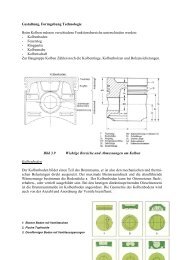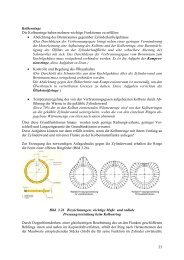XIII. Learning Unit: Malignant Tumors of the Larynx
XIII. Learning Unit: Malignant Tumors of the Larynx
XIII. Learning Unit: Malignant Tumors of the Larynx
Create successful ePaper yourself
Turn your PDF publications into a flip-book with our unique Google optimized e-Paper software.
<strong>XIII</strong>. <strong>Learning</strong> <strong>Unit</strong>: <strong>Malignant</strong> <strong>Tumors</strong> <strong>of</strong><strong>the</strong> <strong>Larynx</strong><strong>XIII</strong>./1.: Keratosis, Pachydermia andLeukoplakia <strong>of</strong> <strong>the</strong><strong>Larynx</strong>Keratosis <strong>of</strong> <strong>the</strong> larynx is a term used to denote a group <strong>of</strong> premalignantepi<strong>the</strong>lial lesions in which an abnormality <strong>of</strong> growth and/or maturationhas occurred. The exact cause is unknown, but smoking, vocal abuse,chronic laryngitis, and vitamin deficiencies contribute.Hoarseness is <strong>the</strong> only symptom. A raised reddish area <strong>of</strong> mucosalirregularity overlying a portion <strong>of</strong> one or both cords with chronicinflammation may be seen during examination.Treatment is as follows.1. Cessation <strong>of</strong> smoking and o<strong>the</strong>r causative agents2. Direct laryngoscopy with excision3. Periodic examination<strong>XIII</strong>./2.: Premalignant Epi<strong>the</strong>lial Lesions;DysplasiasDysplasia, a histological term that characterizes epi<strong>the</strong>lial lesions moresevere than hyperplasia or metaplasia, is potentially malignant anddefined by <strong>the</strong> appearance <strong>of</strong> cellular anomalies in <strong>the</strong> epi<strong>the</strong>lium whichtake <strong>the</strong> form <strong>of</strong> atypical cells with large, hyperchromatic nuclei. Mitosesare more numerous. The cells lose <strong>the</strong>ir polarity and <strong>the</strong>ir stratificationbecomes irregular. If <strong>the</strong>se anomalies are discrete and confined to <strong>the</strong>basal layer <strong>of</strong> <strong>the</strong> epi<strong>the</strong>lium, <strong>the</strong> dysplasia is moderate. In markeddysplasia, <strong>the</strong>se anomalies are more pronounced and extend towards <strong>the</strong>epi<strong>the</strong>lial surface where normal cellular maturation persists. Whennormal cellular maturation ceases, carcinoma in situ begins. In moderateor marked dysplasia, as in carcinoma in situ, <strong>the</strong> basal membrane ispreserved.In all cases <strong>of</strong> chronic laryngitis, it is ultimately <strong>the</strong> presence and extentor absence <strong>of</strong> dysplasia that determines prognosis and <strong>the</strong>rapeuticalapproach. In current practice it is <strong>the</strong>refore considered very useful toadopt <strong>the</strong> histological classification system proposed by Kleinsasser,namely:Stage I: hyperplasia, with or without keratosisStage II: dysplasia, with or without keratosisStage III: carcinoma in situ.Dysplasia is <strong>of</strong>ten a very focal lesion that cannot be detected byendoscopy, thus emphasizing <strong>the</strong> usefulness <strong>of</strong> microlaryngoscopy whichpermits not only detailed and accurate inspection <strong>of</strong> mucosal changes,but also <strong>the</strong> removal <strong>of</strong> large biopsy specimens so essential to <strong>the</strong>pathologist. (Fig. 20.)
<strong>XIII</strong>./3.: Anatomic classification for cancer <strong>of</strong> <strong>the</strong>larynx1. Supraglottis2. Glottis- Epilarynx, including marginal zone- Supraglottis, excluding epilarynx- vocal cords- anterior commissure- posterior commissure3. SubglottisMost (over 95 %) malignant laryngeal tumors are epidermoidcarcinomas. These tumors are found almost exclusively in males aged 40to 70. The incidence <strong>of</strong> <strong>the</strong>se tumors in females is however increasing,and in <strong>the</strong> <strong>Unit</strong>ed States has already reached 25 %.Of all <strong>the</strong> etiological factors considered, tobacco constantly appears to be<strong>the</strong> most important. O<strong>the</strong>r risk factors include alcoholism, toxic vapors,and dusts, particularly asbestos dust.<strong>Malignant</strong> tumors originating in <strong>the</strong> subglottic area are rare (3%).Excepting epilaryngeal tumors, <strong>the</strong> incidence <strong>of</strong> subglottic tumorsapproximates that <strong>of</strong> glottic tumors.<strong>XIII</strong>./4.: Epidermoid CarcinomasUnder endoscopy, a carcinoma in its early stages, still localized andsuperficial, has no pathognomic expression. In apparently healthyendolaryngeal mucosa, it may simulate benign lesion. More <strong>of</strong>ten ithides ei<strong>the</strong>r under <strong>the</strong> cloak <strong>of</strong> chronic hyperplastic laryngitis or underkeratotic lesions. It is known that chronic laryngitis, with or withoutkeratosis, shows malignant transformations, <strong>of</strong>ten delayed, in about 10 to15 % <strong>of</strong> cases. These carcinomas are extremely polymorphic. Somepresent as well circumscribed, finely polypoid, nodular lesions, ando<strong>the</strong>rs, in contrast, spread sheetwise to blend imperceptibly with normalmucosa.The following signs should alert <strong>the</strong> physician:a decrease in cordal movement, a sign suggesting tumorousinfiltration.Induration <strong>of</strong> a mucosal area after palpation, also a signsuggesting tumorous infiltration.Capillary anomalies, as described by Kleinsasser and located on<strong>the</strong> surface or on <strong>the</strong> periphery <strong>of</strong> a malignant tumor, involvingei<strong>the</strong>r an increase in <strong>the</strong> number <strong>of</strong> capillaries, or capillaries <strong>of</strong>varying size with hooked or spiral configuration.Contact hemorrhage (always suspect).In such situations, microlaryngoscopy provides distinct advantages:better visualization <strong>of</strong> lesions; detailed inspection <strong>of</strong> adjacent mucosa;
exploration <strong>of</strong> less accessible areas, such as <strong>the</strong> ventricle, anteriorcommissure, subglottis; and extensive, staged, and better orientatedbiopsies. In fact, it is histology that determines diagnosis. It is <strong>the</strong> qualityand size <strong>of</strong> biopsy specimens that determine <strong>the</strong> accuracy <strong>of</strong> diagnosisand <strong>the</strong> accuracy <strong>of</strong> knowledge regarding tumorous extension. It is <strong>the</strong>aggregate <strong>of</strong> this information that is indispensable for every <strong>the</strong>rapeuticdecision. Overt and larger carcinomas can be readily identified byindirect laryngoscopy. These carcinomas are exophytic or infiltrating,and sometimes ulcerated.The modes <strong>of</strong> invasion <strong>of</strong> endolaryngeal carcinomas are now knownthanks to anatomicopathological studies <strong>of</strong> laryngectomy specimens.Vocal cord carcinomas originating in <strong>the</strong> free border spread more readilytowards <strong>the</strong> anterior commissure and opposite cord than towards <strong>the</strong>ventricle or subglottis.Laryngeal vestibule carcinomas originate on <strong>the</strong> laryngeal surface <strong>of</strong> <strong>the</strong>epiglottis or at <strong>the</strong> junction <strong>of</strong> <strong>the</strong> ventricle and <strong>the</strong> epiglottic base. If<strong>the</strong>y do not generally invade <strong>the</strong> glottic region, <strong>the</strong>y frequently invade<strong>the</strong> preepiglottic space. Mention should also be made <strong>of</strong> two specialtumor locations in which tumorous growth is silent and very difficult todiagnose and appreciate topographically because <strong>of</strong> its very infiltratingnature.Reference is made to cancers <strong>of</strong> <strong>the</strong> anterior commissure and <strong>of</strong> <strong>the</strong>ventricle. The former extend forwards into <strong>the</strong> prelaryngeal space,readily passing through <strong>the</strong> thyroid cartilage which is ossified. The lattermay extend upwards, lifting <strong>the</strong> ventricular fold, laterally into <strong>the</strong>paraglottic space, or downwards toward <strong>the</strong> subglottis. These cancersthus affect three glottic regions, and are referred to in English as„transglottic carcinomas”.Histologically, <strong>the</strong> epidermoid carcinoma presents variable degrees <strong>of</strong>differentiation. In its well differentiated form, carcinomatous cellsfocally conserve <strong>the</strong>ir polarity, stratify, keratinize, and formcharacteristic pearls. In contrast, in its undifferentiated form, only strings<strong>of</strong> anarchically arranged atypical cells are visible. Occasionally, <strong>the</strong>carcinomatous cells may become fusiform and resemble sarcomatouscells. This variant is named pseudosarcomatous carcinoma orpleiomomorphic carcinoma.The histological stage <strong>of</strong> <strong>the</strong> carcinomatous lesion is essentiallydetermined in relation to <strong>the</strong> epi<strong>the</strong>lial basal membrane. If <strong>the</strong> basalmembrane is spared <strong>the</strong> lesion is an intraepi<strong>the</strong>lial carcinoma orcarcinoma in situ. If <strong>the</strong> basal membrane is destroyed, <strong>the</strong> carcinomainvades <strong>the</strong> corium, and if invasion is very superficial it is consideredmicroinvasive. In vocal cord carcinoma, <strong>the</strong> microinvasive stage limitsitself to invasion <strong>of</strong> <strong>the</strong> space <strong>of</strong> Reinke and spares <strong>the</strong> vocal muscle.Very dense inflammatory infiltration <strong>of</strong>ten makes evaluation <strong>of</strong> <strong>the</strong>integrity <strong>of</strong> <strong>the</strong> basal membrane very difficult. The difficulty <strong>of</strong>diagnosing certain forms <strong>of</strong> well differentiated carcinoma, particularlywhen biopsy specimens are inadequate or too superficial, must also bestressed. An extreme example <strong>of</strong> this difficulty is provided by verrucouscarcinoma, a rare anatomicoclinical entity. In endoscopic examination,this carcinoma presents all <strong>the</strong> characteristics <strong>of</strong> an invasive tumor.However, in histologic examination it presents as a papillary tumor inwhich <strong>the</strong> cytologic and histologic criteria for malignancy are absent.In <strong>the</strong> process <strong>of</strong> formulating his diagnosis, <strong>the</strong> pathologist can, <strong>of</strong>course, evaluate only <strong>the</strong> biopsy specimen made available to him. The
fact that a biopsy only discloses simple epi<strong>the</strong>lial hyperplasia does notexclude <strong>the</strong> possibility <strong>of</strong> dysplasia or carcinoma in situ some distanceaway. Similarly, a histologic diagnosis <strong>of</strong> carcinoma in situ does notexclude <strong>the</strong> possibility <strong>of</strong> invasive or microinvasive carcinoma in <strong>the</strong>immediate vicinity. Close cooperation between <strong>the</strong> endoscopist andpathologist will limit <strong>the</strong>se possibilities to <strong>the</strong> minimum. Discussion <strong>of</strong>doubtful cases will lead to repeat biopsies.The typical example <strong>of</strong> this is that <strong>of</strong> chronic laryngitis with dysplasia(stage II), which requires regular endoscopic and histological follow-ups.<strong>XIII</strong>./5.: O<strong>the</strong>r <strong>Malignant</strong> <strong>Tumors</strong>A few unusual epi<strong>the</strong>lial tumors, such as adenocarcinoma,mucoepidermoid tumor, adenoid cystic carcinoma, and carcinoid shouldbe mentioned.S<strong>of</strong>t tissue tumors include fibrosarcomas, chondrosarcomas, andrhabdomyosarcomas. Leiomyosarcomas are unusual and may derivefrom vascular smooth musculature.Laryngeal lymphomas are unusual and only a very few rare cases havebeen reported.
















![epidemiológiai módszerek [Kompatibilitási mód]](https://img.yumpu.com/40130327/1/190x134/epidemiolagiai-madszerek-kompatibilitasi-mad.jpg?quality=85)